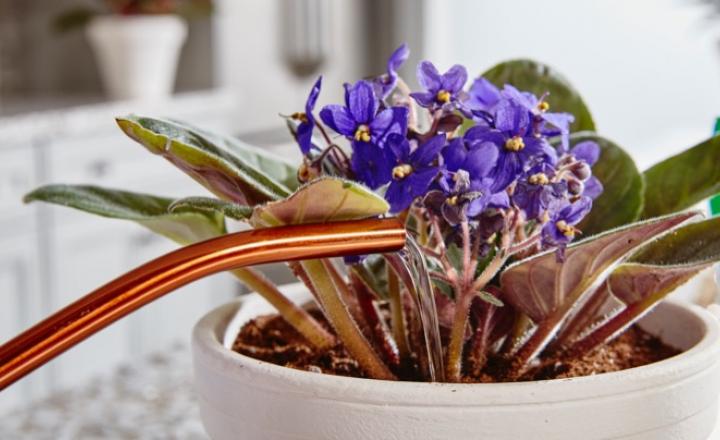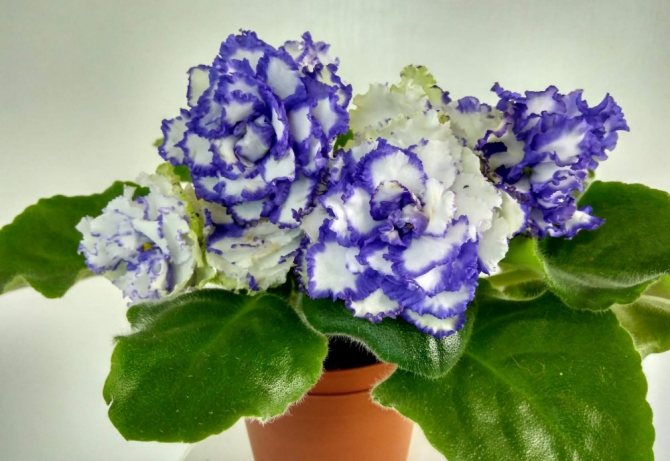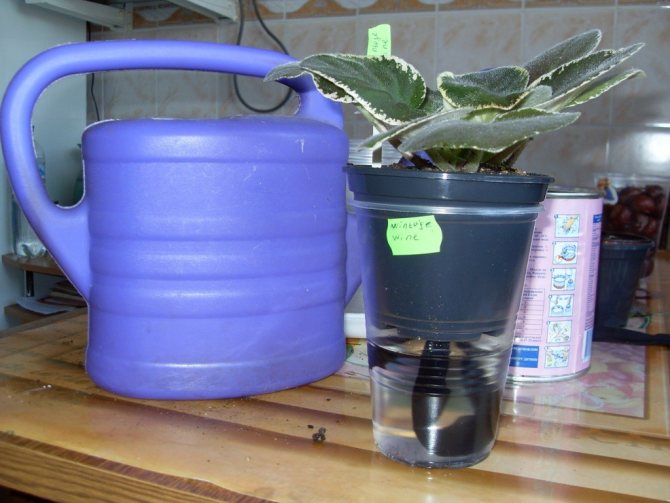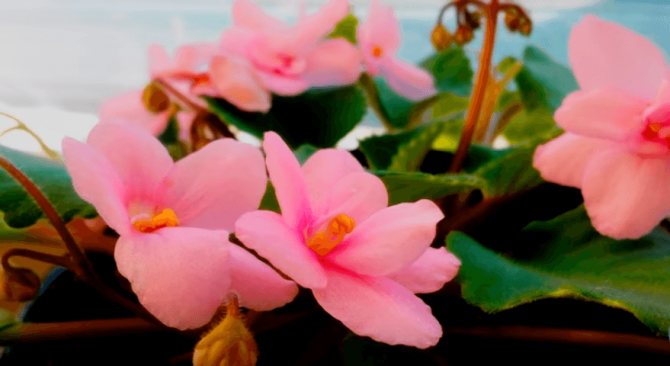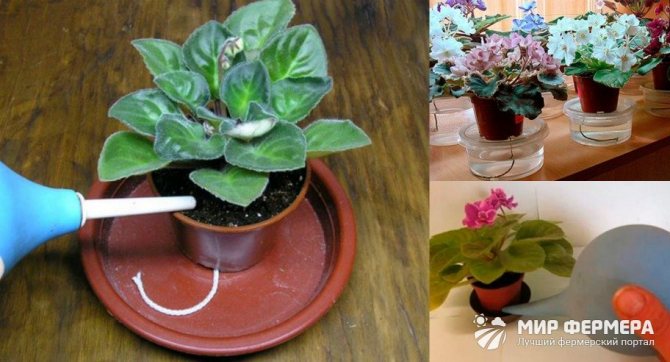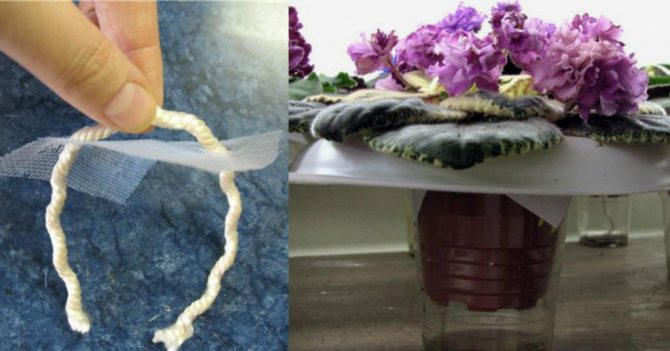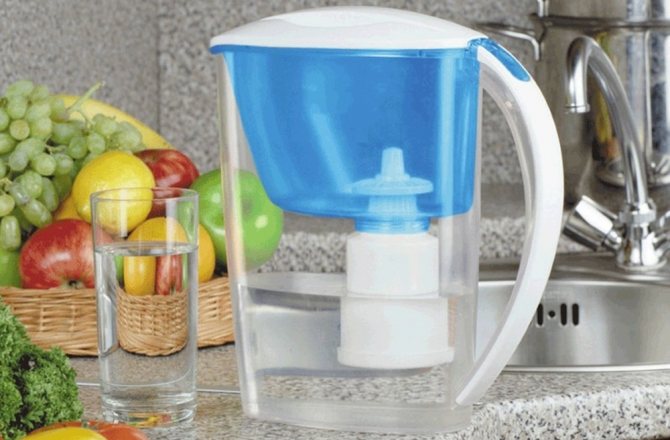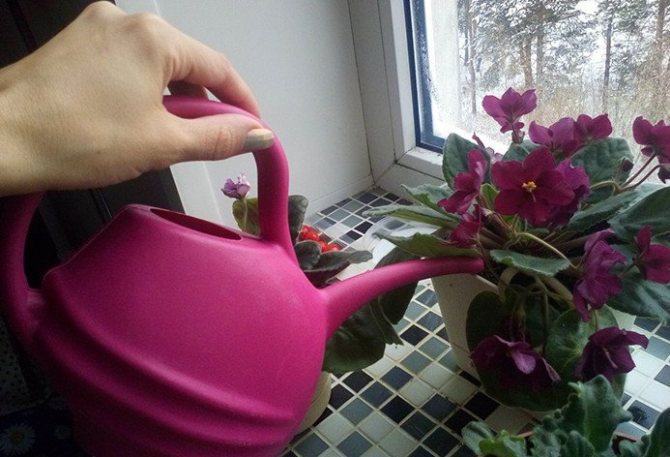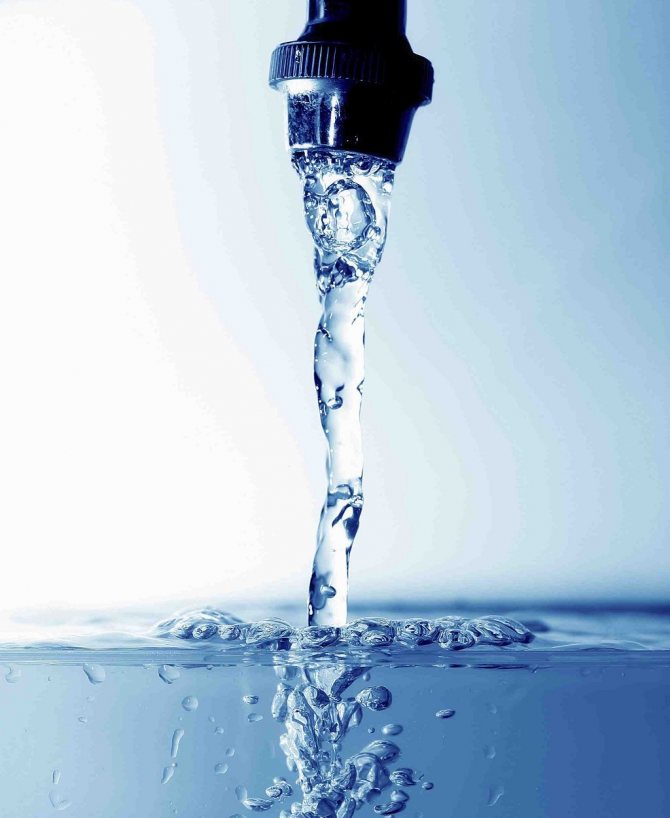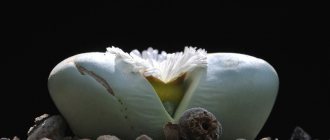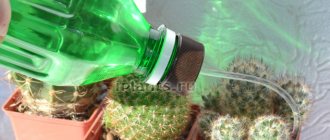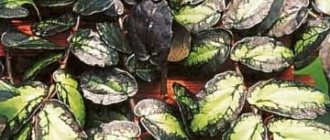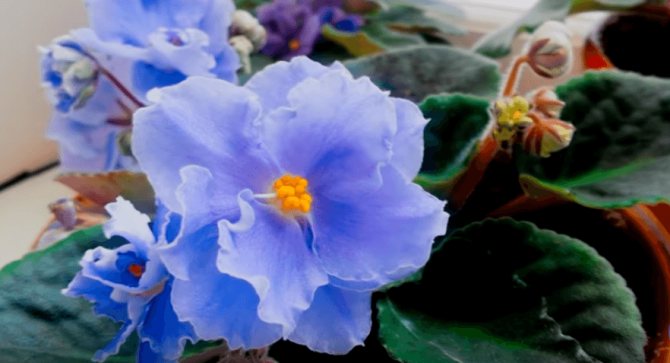
Violet is one of the most common indoor flowers, but, as practice shows, only a few flower growers have this plant taking root. The reason is that the violet requires regular careful maintenance. In the case when the necessary standards are met, it pleases all year round with a rich shade of foliage and lush colorful flowering.
How to tell if a violet needs watering?
Lack of water makes the plant look sickly. Flowers quickly fall off, curl, turn yellow or dry. This also happens with the leaves of violets. Each plant has its own watering requirements, so the standard algorithm may not work.
Reference! The main criteria for the frequency of watering violets are room temperature, illumination, pot size, season and soil quality.
Too much water for a plant can be worse than drying out the soil. Sometimes the soil can get dry on the surface of the pot, but remain moist at the bottom. Therefore, it is recommended to pierce the soil to the base with your finger or stick. This must be done carefully so as not to damage the plant's root system.
Water requirements
The above is about how to water violets at home. However, the health and longevity of a plant depends not only on whether the correct method is chosen. It is also important to know what the water should be.
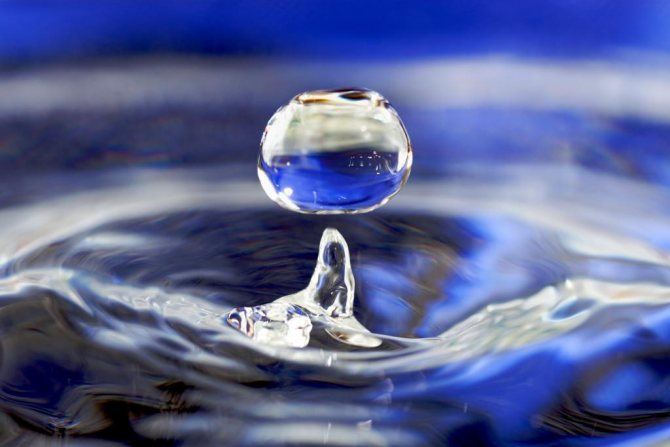

More recently, rain and melt water was used to water indoor plants. Unfavorable ecology put an end to this. Now such water will not benefit the violet, but harm. It is also dangerous to water the plant with plain chlorinated water from the city water supply. As a result, a white bloom forms, which does not allow useful trace elements to penetrate into the root system.
What to do? Water from the water supply system must be defended for several days. If this is not possible, it should stand for at least 10-12 hours. Then it needs to be boiled, cooled to room temperature. After that, citric or acetic acid dissolves in the liquid. In the first case, you should use up to five crystals per liter of liquid, in the second - a teaspoon of the product is dissolved in a liter of water.
If the concentration of chlorine in tap water is very high, filtration cannot be done without filtration. The liquid must be passed through filters that do not contain silver. The same rule applies to river and well water.
How often to water?
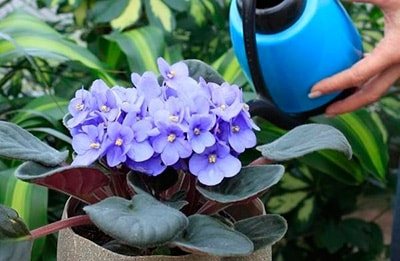

It is recommended to water the violets at the same time. It is impossible to determine the exact frequency of watering the plant, the flower's need for water depends on the following factors:
- Lighting. Bright light dries the substrate faster.
- Air humidity. At low humidity, the plant requires abundant watering (summer, late spring and early autumn).
- The development of the root system of the plant. Well-established or old roots will dry out quickly.
- The moment of flowering. Flowering plants consume more water.
- Soil composition. Dense soil requires less moisture than loose, lightweight soil.
- Air temperature. At low temperatures, the soil stays moist longer.
Experienced gardeners recommend watering violets in the morning in the warm season, and in the afternoon from November to February.
How violets reproduce
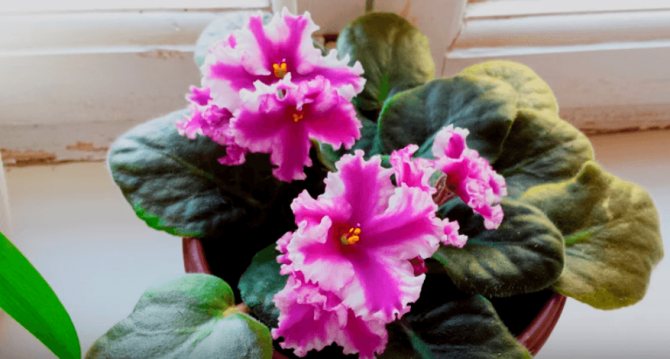

There are different ways of breeding Saintpaulias:
- Rooting the cuttings in water.It is enough to cut off a healthy leaf, put it in water in a warm, bright place without drafts. As it evaporates, add water, and with the appearance of roots, transplant it into the ground.
- Rooting the leaf in the ground. In a similar way, a cutting is obtained, which is determined in the already prepared soil. The main thing is to constantly spray the surface of the soil.
- Seed propagation, which is a laborious process available to experienced growers.
- Reproduction by children. At the base of an adult plant, a specialist's gaze is determined by a shoot, which is carefully separated and transferred to a prepared container with a properly selected soil.
Watering methods for violets
To improve flowering frequency and plant health, gardeners use completely different watering methods. Let's consider the most popular ones.
Wick
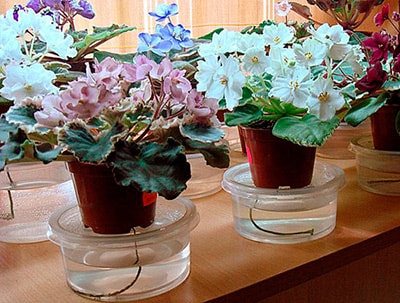

A great alternative for those who often leave flowers unattended.
With the help of a wick, water flows evenly into the pot. The technology is simple: you need to lower the wick into a container with water, and insert its other end into the drainage hole in the pot.
The latter should be located above the container with water, without touching its bottom. If this is a miniature plant, then a large plastic glass will be an excellent alternative for the design.
You can use a lace as a wick, it perfectly absorbs moisture. Here the plant independently decides when to "drink water". This method of irrigation is not recommended in winter, when the water in the container may freeze.
Into the pallet
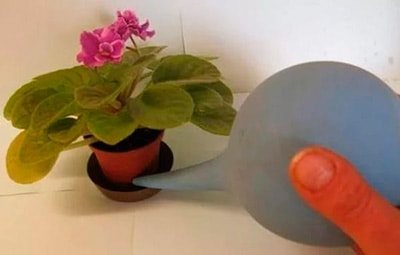

This method of watering violets is very well perceived in the cold period.
Water must be poured evenly, depending on its absorption by the soil.
The tray with water should be left for 10-15 minutes.
Excess fluid must be drained.
The immersion method or the Texas watering method
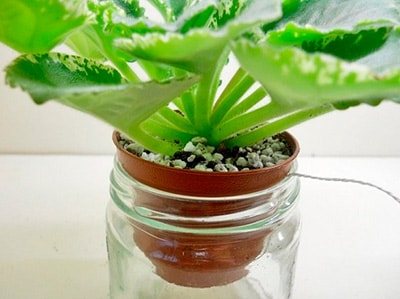

If you are ready to get confused and build a whole structure for your favorite plants, you will need:
- drill holes on the sides of the pot at a height of 5 cm from the bottom;
- coarse perlite lays down to the level of the holes, and a layer of earth on top;
- the pot is placed in a small cuvette and water is poured up to the level of the holes made. The latter are not filled with water so that air flows to the root system;
- the water level does not exceed the drainage level.
For this method of irrigation, it is recommended to use a soil with fibrous peat and perlite to ensure the capillary effect. The components do not dry out the soil substrate, contribute to the abundant flowering of the plant.
Upper
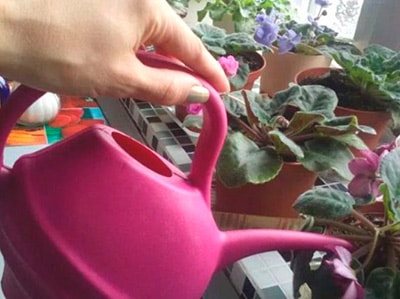

This classic watering method is good for violets, if you do not use a spray can. The water should go under the root or soak up the edge of the pot.
For watering, use a syringe without a needle, a syringe, or a watering can with a narrow nozzle.
The water should be absorbed, not flowed out. The liquid is poured until it begins to appear on the pallet. After 15-20 minutes after watering, you must drain the excess water from the sump.
Drip
As with the previous method, you must use a narrow-nosed watering can or a syringe. This method is used for miniature Saintpaulias.
Why does the violet not bloom
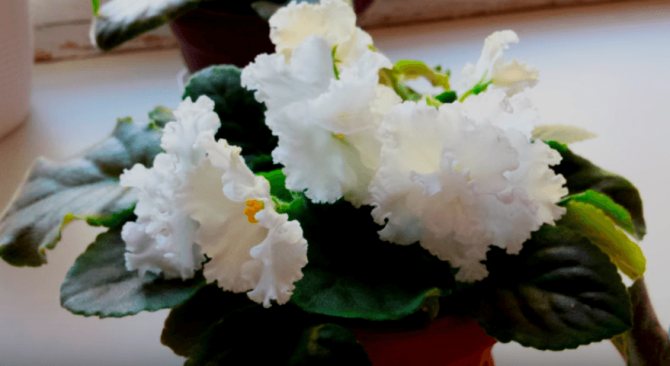

There may be no flowers on Saintpaulia for various reasons, which are determined by the appearance of the plant:
- If the bush consists of many dense sheets of saturated color and different sizes, the reason lies in an excess of nitrogen in the soil. It is necessary to cut off some of the leaves and interrupt the additional feeding.
- Compaction of the soil, which is possible with the initially wrong choice of the constituent parts of the soil. It is also possible in the case when the plant has not been transplanted for a long time.
- The pot is too big. It has long been noted that violets exist more comfortably in small-diameter pots.
- If the leaves of the plant are pale and long, this sign shows a lack of light.
- Direct sunlight reduces the overall immunity of the violet, which is fraught with burns, fungal diseases and lack of flowers.
- Standing water in the pot indicates root rot and, consequently, insufficient drainage.
- Dry potting soil despite regular watering. In this case, you need to keep a container of water near the pot with a violet to humidify the air.
How to water at different times?
Seasonality affects the condition of the plant's root system, the healthy appearance of the leaves and the abundance of flowering. Consider the flower's need for moisture and the tolerance of hot weather or cold.
In winter
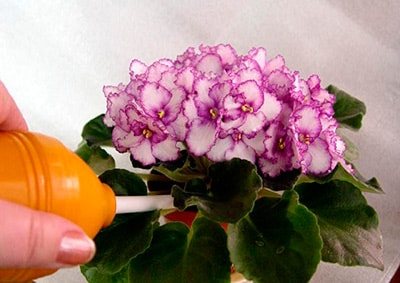

In the cold season, the violet requires special care. The plant needs rest.
It is recommended to reduce the frequency of watering, reduce the abundance of light and completely eliminate fertilization of the soil.
In winter, it is recommended to remove the flower buds to keep the violet strong for overwintering. The abundance of water during this period is poorly absorbed by the root system.
Important! If the roots of the plant have begun to rot, the flower can be saved with a temporary transplant. Reducing moisture levels and new soil will give the violet a chance to recover.
In summer
In a hot season, try to provide the plant with an indoor air temperature of up to 25 degrees. This is the optimum temperature for an abundant and long-lasting flowering.
In unbearable heat, air conditioning can keep the plant from rotting and drying out. Heat is not a reason for abundant watering of a flower. The already known watering methods can be alternated with each other.
In spring and autumn
This is a favorable time for transplanting and feeding the plant, as well as the most optimal air temperature for the growth of violets. In the spring and autumn, the plant blooms most abundantly, and also perfectly accepts any method of watering.
Temperature regime for violets in winter
As already mentioned, violets are very whimsical to the temperature regime. For them, both heat and cold are destructive. At the same time, the lower critical temperature is +12 degrees, and the upper one is +29. Prolonged exposure to a cold room can lead to burns and leaf decay, as well as shedding of inflorescences (Figure 2).


Figure 2. Plants should not be placed next to heating radiators
Overheating leads to excessive evaporation of moisture from the surface of the flower and yellowing of its aboveground part, and also contributes to the occurrence of diseases. Therefore, the most optimal indicators are those that fluctuate from +20 to +25 degrees. The only exception is the seasonal respite, during which the plants are taken out to a cool place for several days.
Feeding violets at home
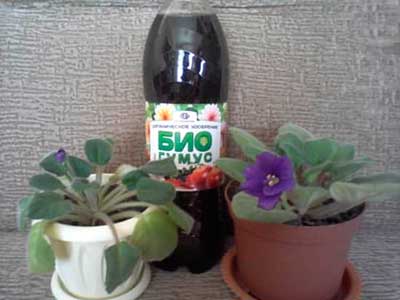

Over time, the soil loses its beneficial minerals and trace elements, therefore it needs periodic recharge. To fertilize a home plant, you can alternate the following components:
- Nitrogen
- Phosphorus
- Potassium
The first option is suitable for a period of active growth when new leaves are being formed. With an excess of fertilizers, the violet will stop blooming. Potassium and phosphorus will speed up bud formation and continue to saturate them with missing components during flowering.
It is necessary to fertilize violets no more than 1-2 times a month. You should not apply top dressing immediately after transplanting, at high or low temperatures, or damage to the root system. To protect the leaves of the plant from damage, it is better to fertilize the flower through the pallet.
Do violets bloom in winter
Indoor violets are capable of pleasing the eye with abundant and bright flowering all year round, including in winter (Figure 4).
To do this, they need to create the following conditions:
- Optimal temperature conditions (+ 20-25 degrees);
- Lack of drafts;
- Diffused sunlight;
- Sufficient daylight hours (at least 12-13 hours a day);
- Timely and reasonable watering, when the earthen ball is constantly kept moist, but not wet;
- Optimum humidity of the environment, to which flowering plants are especially sensitive;
- Plants are protected from harmful insects, most often thrips, mealybugs and cyclamen mites, by watering with a weak solution of potassium permanganate, which not only disinfects the substrate, but also acidifies it, which has a beneficial effect on the flower.
- Regular feeding (once every 2 weeks) with fertilizers with a high potassium content are carried out in summer, autumn and spring. In winter, it is recommended to refrain from them to give the violets a break.
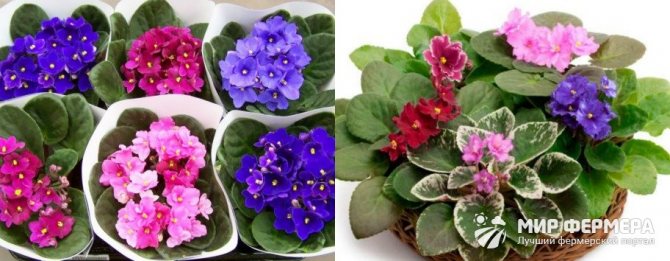

Figure 4. Blooming violets in winter
By following these basic tips, you will be able to provide your violets with optimal care and they will delight you with stable and long flowering throughout the year.
If you are interested in more detailed information on the application of theoretical knowledge about caring for violets in summer and winter, we recommend that you watch the video in which an expert on indoor plants tells in detail how to care for these tropical crops in the winter at home.
What kind of water is needed?
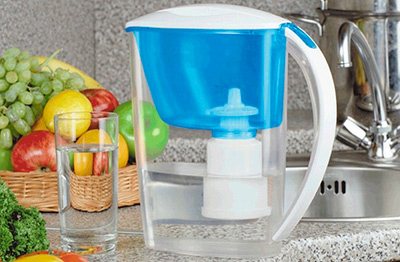

Periodically, it is necessary to wipe the violet leaves with water at room temperature.
Flowers should not be watered with freshly collected tap water.
Not everyone has the ability to use drinking water or filter available water. This method will help make running water a panacea for violets:
- The required amount of tap water is left for a day in a room with room temperature.
- During this time, the water must be stirred several times so that the free chlorine evaporates.
- Boil the liquid for 1 minute.
- Add a pinch of citric acid.
- Let the water brew for 2 hours and pour it into another container until sediment.
Remember, the root system of violets prefers warm water up to 40 ° C. Therefore, before watering itself, it can be slightly warmed up.
Through the pallet
How to water violets through the pallet? This requires a bowl or similar container. The pot with the plant is placed in a tray, which is filled with water to a quarter of its height. After a while, the soil will absorb the liquid and darken. This indicates that the required moisture level has been reached. In no case should you overexpose the violet, as this will lead to waterlogging of the earth.


It is important to remember that several flower pots cannot be placed in the same pallet. If even one violet is affected by a disease, it will infect other plants. It is also important that the leaves of the plant do not touch the surface of the water.
Pallet irrigation has a significant drawback. This method does not ensure the washing out of harmful salts from the soil, as occurs when using the drip method. They enter the topsoil and remain in an earthen coma. It is necessary to carefully monitor the quality of the water used for irrigation.
Why add potassium permanganate?
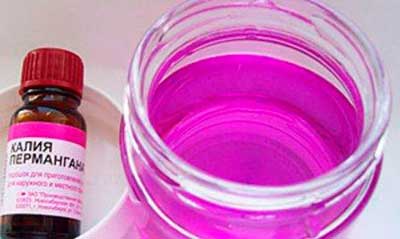

Previously, gardeners actively used this methods of treatment and plant nutrition.
Nowadays, chemical dressings are more popular. Do not forget that this is a good prevention of diseases and elimination of plant infections.
Potassium permanganate is used as an irrigation. The concentrated solution can kill the plant. Therefore, 3 drops of potassium permanganate should be added to 1 liter of water.
What water to water violets
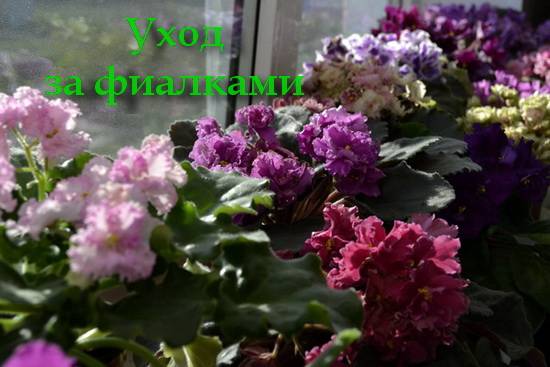

Usambara violet.
Family Gesneriaceae - Gesneriaceae.
Genus Saintpaulia hybrida - Hybrid Saintpaulia.
African violet saintpaulia hybrid.
What water should be watered violets.
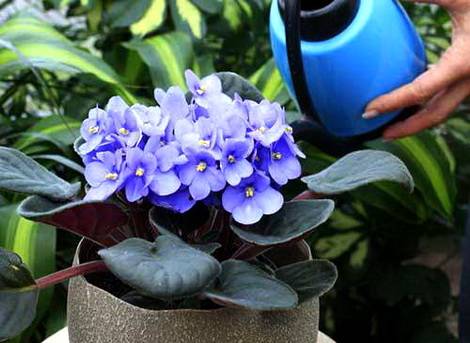

It is important how and what you will water and feed the violets. Water for irrigation Saintpaulia is characterized by two main parameters: hardness and acidity. Hardness is understood as the content of calcium and magnesium salts in water. The acidity of water is expressed in conventional units of pH, the higher the degree of acidity of the water, the lower the pH value.
Hard water leads to alkalization of the soil, and the digestibility of the main components of the soil: nitrogen N, phosphorus P and potassium K directly depends on the irrigation water and soil acidity. With constant watering with hard water, the earthen lump becomes alkalized over time. The earth becomes not slightly acidic (with a pH value of 6.5), which violets love, but close to neutral or even alkaline (pH greater than 7).
Due to the excess content of calcium salts in the soil, the roots cannot absorb some elements, for example, iron, magnesium, although they are present in sufficient quantities in the soil. Many fertilizers act only in a weakly acidic environment, while in an alkaline environment they become insoluble and are not absorbed by plants. For example, take settled tap water and add liquid fertilizer to it, and you will see how the water becomes cloudy. This means that most of the fertilizer has precipitated.
Thus, such water will not dissolve nutrients in the soil, and it will be difficult to regulate N, P, K. Lack of potassium disrupts nitrogen metabolism: ammonia accumulates in the cells, which causes tissue death. Phosphorus is the main element that provides energy processes in the cell, and it is necessary during all periods of a plant's life. It is potassium and phosphorus that dissolve the worst in hard water.
The problem of water in our water pipes is hardness, it contains a lot of salts, gradually the soil, the pot and even the center of the outlet can become alkalized. Watering plants with hard water constantly can cause a white crust to form on the soil surface. It does not pose any harm in itself, but Saintpaulia needs soft water. You need to soften the water. The addition of a certain amount of boiled water to the settled water by about 1: 3 will slightly reduce the hardness.
It is advised to use oxalic acid for this. Dilute 20 grams per liter of water - this is a concentrate. For watering 1 tsp. concentrate per 1 liter of water. But when using it, the salts turn into an insoluble form and you need to apply additional filtration or wait a long time for the precipitation of salt flakes. Citric acid, only acidifies, and oxalic acid makes water soft, you can find it in a pharmacy for animals, or beekeeping.
It is known that the optimum soil acidity corresponds to a pH value of 6.4 to 6.9. For watering violets that need a slightly acidic environment, the most suitable methods for reducing hardness (filtered cold tap water), (cold tap water with peat), (cold tap water with apple cider vinegar).
The acidity of the water is regulated depending on the acidity of the soil; at a pH of more than 7.0, apple cider vinegar, citric or oxalic acid are added to the water, which in turn reduces the hardness of the water and allows the plant to properly absorb nutrients. Dolomite flour reduces acidity.
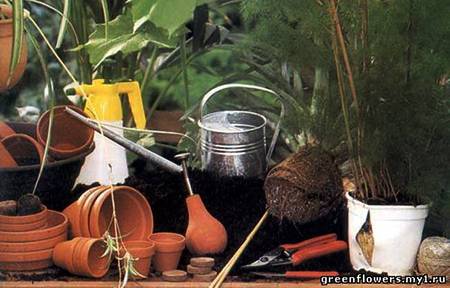

Natural apple cider vinegar, citric acid and vinegar are used to neutralize water. According to experience, 1-2 drops are enough per 1 liter of water. It is good to use ash (10-15 g) or peat (20-30 g). Ash (peat) is placed in a gauze or linen bag, which is immersed in water for a day, then using it to neutralize. Constant acidification of water makes it possible to keep the soil in a slightly acidic state. And this, in turn, affects the brightness of the flowers and salt deposits do not form so quickly on the soil surface.
Adding Citropac to the irrigation water (1/4 tablet per 5 liters of water) will lower the pH of the water due to citric acid contained in the citropac and reduce the number of soil insects due to the caffeine contained in the cytropac.
The high hardness of water for plants in acidic peat soil is less dangerous. For some time, lime, getting into this soil, will be neutralized.However, over time, such soil becomes saline. Many fertilizers also have a soil acidifying effect. These are, for example, ammonium chloride, aluminum sulfate, urea, potassium salts.
Other methods can be used to combat soil salinity, among which, in addition to transplanting, the annual replacement of the upper saline soil layer with a new one. Many plant lovers mulch the soil, covering its surface with a layer of sphagnum. Moss, besides retaining moisture, absorbs all salts. True, sphagnum must be periodically changed, removing it from the dried substrate.
One way or another, the basis of the normal state of the plant is still high-quality settled soft water, which is best absorbed by the plant and ensures optimal growth. In hard water, it is preferable to water the pot with the plant on top: this will wash out excess salts.
When growing saintpaulias, you need to make sure that the nutrients are absorbed by the plant and the N - P - K ratio is manageable, but this is only possible with gentle watering. Distilled water is completely devoid of salts and has the property of actively adsorbing them onto itself. With regular irrigation with distilled water, all salts are washed out of the ground - both “harmful”, which form a crust on the surface, and “useful” - fertilizers. Over time, the flowers starve, they grow and bloom worse.
Continuation: Watering violets.
Continuation: How often the violets should be watered.
Continuation: How to properly water violets.
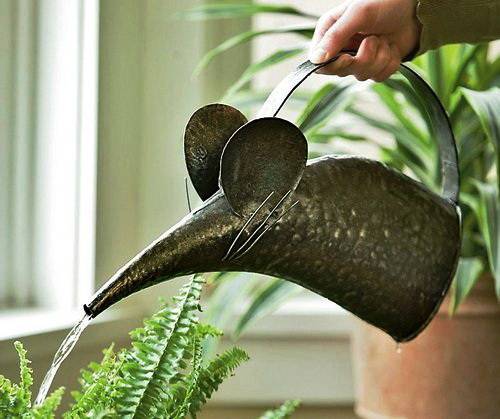

Possible mistakes or fake tips
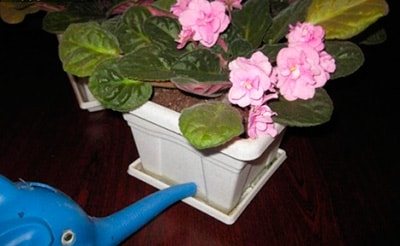

Violets are very demanding plants with a poorly developed root system. (?) Remember that every plant needs diligent care. Due to overflow or abundant sun, Saintpaulia may die.- If you water a violet from above, it can rot. (?) The presented methods of watering have a beneficial effect on the root system. When choosing a method for watering violets, it is necessary to focus on its habitat.
- Violets do not tolerate transplanting well. (?) For good growth, the flower is planted in a small pot. The soil in such an environment is quickly depleted, so you need to replant the violet at least twice a year. The favorable period for transplantation is March and September. Transplanting the plant into fresh soil in the spring promotes abundant flowering, and the autumn procedure will give strength to the flower for overwintering.
- To bloom violets, it is necessary to tear off the lower leaves. (?) The flowering of violets is influenced by proper care, and not by the number of leaves. With good lighting conditions, temperature and proper watering, the plant will bloom profusely and with few leaves. The juicy and healthy bottom leaves give the violet the strength to bloom abundantly.
When watering the plant, water should not enter the leaves, stains remain from burns, the violet begins to ache. Its leaves are covered with a fine fluff, on which dust forms. Such a plant needs a "shower", it is recommended to wipe the leaves with warm water. A wet flower must be protected from the sun and drafts.
Caring for violets in winter
One of the main conditions for caring for violets (Saintpaulias) at any time of the year is their correct location in the room. Since in their homeland, in the jungle, violets are accustomed to warmth and diffused sunlight, it is recommended to place pots with these plants near the western or eastern windows, preferably not on the windowsill, but on a small table or rack. In this way, you will be able to provide the required amount of diffused sunlight (Figure 1).
Note: You should be aware that violets do not tolerate permutations well, so try not to disturb them in vain. Yellowed foliage will serve as a signal of trouble. In this case, it is necessary to turn the plant with its yellowed side towards the sun.
The diameter of the pot and the composition of the substrate are also important points.So, the diameter of the vessel in which the Saintpaulia grows should not be too large. The most optimal size is 15 cm. The pot must be filled with loose soil without lumps. To do this, you can use a ready-made substrate for violets, or prepare a mixture yourself from ordinary garden soil and expanded clay (in a 1: 1 ratio).


Figure 1. In the cold season, flowers require increased attention
With regard to winter care, the main difficulties are associated with such basic points as temperature drops, low air humidity and the risk of decay due to overmoistening of the earthen coma.
Frequently asked questions
Why doesn't an adult violet bloom with proper care and watering?
- Violets love small pots and good lighting. Prolonged heat and low humidity also affect the abundance of flowering. Sometimes stepchildren can form instead of peduncles. They should be removed and placed in a cool place for a while.
What to do with a long, bare stem of a violet?
- The flower must be carefully removed from the pot, scraped off the stem to a juicy tissue, then planted in new soil to the depth of the lower leaves.
Dark spots appear on the leaves, what is it?
- They can appear from drafts and when the leaves remain wet for a long time.
What is the best soil to use for violets?
- Although this plant is unpretentious, we recommend choosing a loose and nutritious mixture with a neutral acidity index: ph from 5.5 to 6.5.
Did you know? The first mention of violets is associated with the ancient Greeks. They considered this flower a symbol of love and fertility, adding plants to love potions, tea and wine. The violet was also a great seasoning for meats and desserts.
After transplant
Transplanting is a crucial moment in the life of any plant. It is enough to make one mistake for the flower to die irrevocably. The violet needs not only to be correctly transplanted, it is also necessary to take proper care of it after the completion of this procedure. An important part of it is competent watering.
Watering a newly transplanted violet too often will result in its death or illness. Wait until the soil in the container is one third dry. Only then can the plant be watered. The choice of method does not play a significant role.
Why is it important to do it right
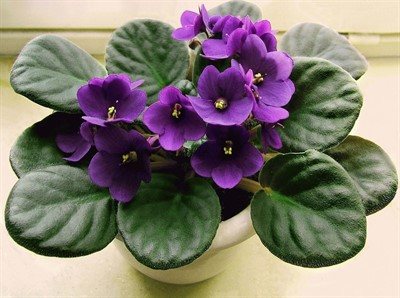

Violet is very picky about the quality of watering. She is a visitor from South Africa and therefore cannot stand waterlogging., especially if water enters the center of the flower - the so-called growth point.
A white bloom forms on the stem, after which it begins to rot. The lower leaves also disappear.
The root system is covered with a black bloom; it absorbs moisture from the ground worse.
As a result, water and useful trace elements are not delivered to the plant organs in the required amount, which can give rise to the processes of decay and death of the flower.
Although the violet tolerates drought better than waterlogging, lack of watering may not have the best effect on the plant. At first, the leaves become lifeless and lethargic, the flowers fall off.
In the absence of watering, the flower dries up.
If violets do not grow, than water
If the plant does not grow, then you should also take a closer look at the conditions of its residence. Perhaps he lacks moisture, light, and the pot is too small. If everything is observed, but the violet still does not grow, then you can water it with special compounds to activate growth, which are sold in gardening stores. The main thing is to observe the recommended dosages when applying the solution. Otherwise, the plant may die.
In the video, the florist tells and shows how to make wick irrigation for violets.
Top dressing with mineral preparations
How to water indoor violets to keep them healthy and beautiful? Unfortunately, pure water is not enough for this. From time to time, the plant needs to be fed with mineral preparations.
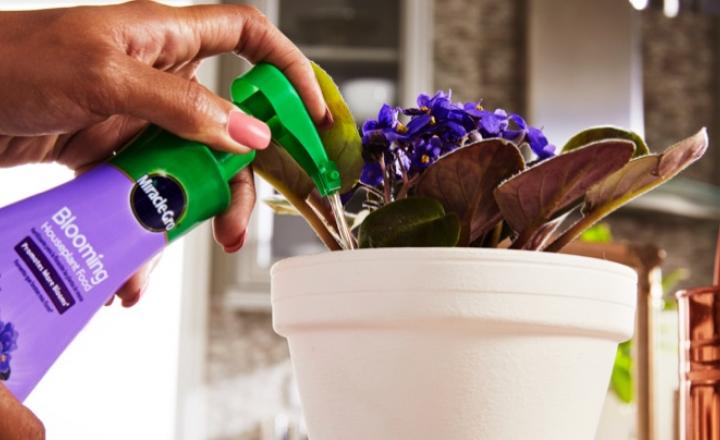

The simplest solution is to purchase a special composition that is designed to enhance growth and flowering at home. "Garden of Miracles", "Master Color", "Uniflor-Bud", "Mister Color" - it can take a long time to list popular brands that produce liquid fertilizers.
Experienced gardening tips, watering mistakes
Gardeners' recommendations will help you avoid common mistakes in watering violets and preserve the beauty of the flower:
- Beginning flower growers are worried if the leaves are dry on a violet, whether it is possible to spray them - no, this is not recommended. If the indoor air is dry, they can be wiped with a damp cloth.
- If the plant suffers from overflow, it is reanimated with a 0.02% succinic acid solution. Another way is liquid vitamin B12 (1 ampoule per 1 liter of water).
- It is forbidden to pour water on the leaves under any circumstances, as well as splashing on them.
- Do not leave water in a container under a flowerpot. It must be removed 15-20 minutes after watering.
- Transplanted violets cannot be wetted with a wick method; they need at least 20 days to recover.
- Small or young flowers are best watered with a small enema.
Watering violets is a responsible business. The intensity of growth and flowering of beautiful, exquisite flowers depends on the quality of water and the frequency of moisture.
Recommended varieties for beginner florists
Novice growers are afraid to harm, they often make mistakes, therefore, unpretentious varieties that are easy to handle are recommended for them:
- Chanson. They say about him that he can bloom under any circumstances. It is unpretentious, requiring only regular watering and feeding once during each season. The appearance of this variety is beautiful. It blooms in large flowers, like "stars". Most often, a bright purple hue, double flowers, wavy edges.
- Pink Panther. Requires content in darkened conditions, blooms in pink flowers with a white border.
- Spring. It has simple wavy white buds, spots of different shades are scattered over the entire area of the petal. The leaves are large, dark green in color.
Representatives of the family are least susceptible to diseases, are patient with systematic drying of the soil, forgive the lack of watering, but do not like excess moisture.
Flower features
Violet, or Saintpaulia, is a guest from hot Africa, so the plant has the following characteristic features:
- does not tolerate cold;
- drought is the enemy for such flowers;
- over-watering can also kill plants;
- when moisture gets into the middle of the flower, saintpaulia can begin to rot.
What are the signs that you can understand that the violet needs to be watered? There are several of them.
- The substrate in the pot has become light, and small cracks have formed on its surface.
- The leaves of the plant wilted and wilted.
Signs of waterlogging are as follows:
- the lower leaves of the plant began to wither, fall off;
- the substrate is moist, dark;
- a large amount of liquid accumulates in the sump.
This information will help growers understand the needs of green pets and water violets correctly.
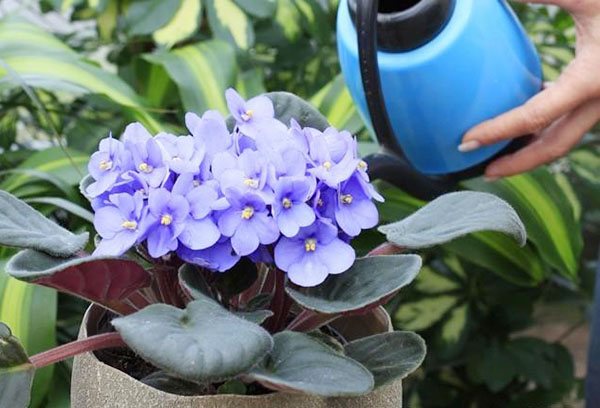

Flower history
The homeland of the violet is the Uzambara and Uluguru mountains in Africa. It was here that these delicate and beautiful flowers were first discovered. Violet received the name Uzambar. The second name of the plant is saintpaulia. The German commandant of the Usambar District of German East Africa, Walter von Saint-Paul, was captivated by the grace of the plant. It was he who first discovered this flower in 1892 and described it.
They began to breed the African beauty in Europe thanks to Baron Saint-Paul. He sent the collected seeds to his father, who gave them to the German botanist Hermann Wendland. This is how the history of the conquest of Europe began. The violet was officially presented to the world in 1893 at the International Flower Show. It was reviewed in the magazine Gartenflora, which was very popular in those years.
In the wild, Saintpaulia is a herbaceous plant up to 30 cm high. The shape and color of flowers depend on the variety. Violet inflorescence petals can be oval, heart-shaped, round, have serrated or smooth edges. The color range of the plant ranges from white to purple. The domestic African violet is much smaller in height, but does not differ in beauty from its wild predecessor.
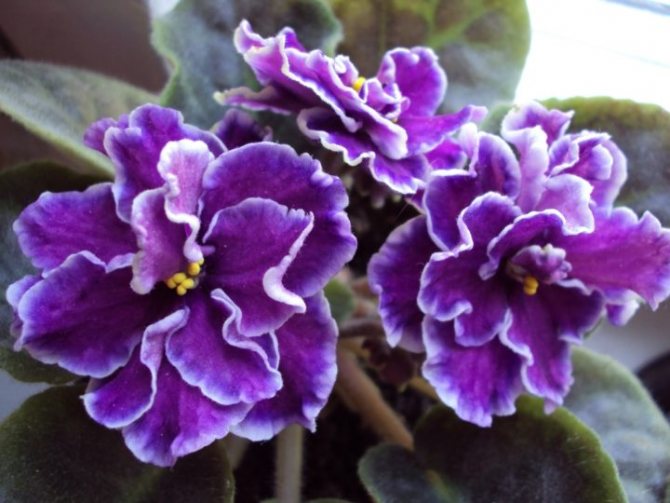

Violet
There are a huge number of clubs for lovers of these plants. Rare varieties of Saintpaulia are bred, exhibitions are arranged, amateur gardeners share the secrets of caring for this amazing plant.
In winter
At different times of the year, Saintpaulia behaves differently, in winter it often begins to dry out, becomes lethargic. Many owners of a flower try to feed, actively water it, believing that they do not receive additional nutrition or moisture in winter. This is not entirely true.
In winter, violets need less water, but more moisture due to the dry air that is artificially created by heating devices. The way out of this situation is quite simple. The frequency of watering can be safely limited, but at the same time the quality of humidification can be ensured. On the windowsill next to the pot, place a sponge soaked in water or place a filled container. Sometimes the batteries are covered with wet rags, this saves the plants from dry air, they come to life again.
Major mistakes
Watering is not only the main and most important condition for keeping, but also the territory where many mistakes are made. Novice collectors are afraid to overfill, but dry it up instead. After receiving a disappointing result, in an attempt to rectify the situation, many transfuse the plants, and this becomes another mistake.
If the tips of the leaves are dry in Saintpaulia, or the soil becomes too dry and hard, then the best solution is to apply watering in the pan. The procedure will gradually make up for the lack of moisture in the amounts that it needs. Signs that Saintpaulia is dry:
- the soil is dry;
- water does not leave the sump for too long (due to the loss of the ability to absorb);
- kind of drooping limp leaves.
Signs of a flooded plant:
- the violet stopped growing;
- the soil is always moist;
- the leaves turn yellow, the petals rot along the edges.
How to avoid them
Care errors can be avoided. The basic rule for watering Saintpaulias is not strict adherence to instructions, but a daily assessment of the condition of the flower. Important! Covering leaves with yellow spots indicates an overdose of fertilizers.
Signs of improper watering
If the plant lacks moisture, it will inform the owner about this by changes in appearance:
- Spots appear on the leaves, roots die off... This occurs when the soil is excessively moist and acidic, which prevents nutrients from reaching the roots.
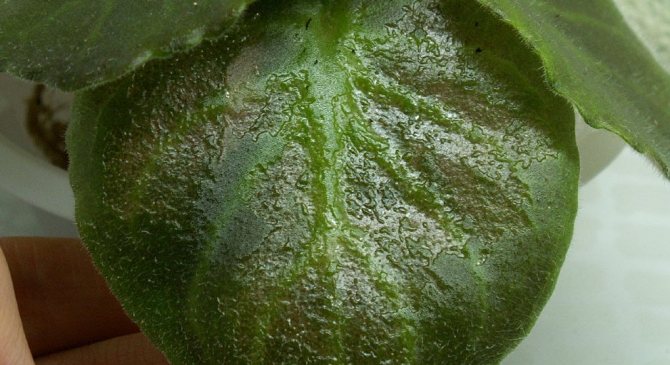

- Rotting point of growth... This situation is observed with top watering and frequent ingress of moisture on the organs of the flower.
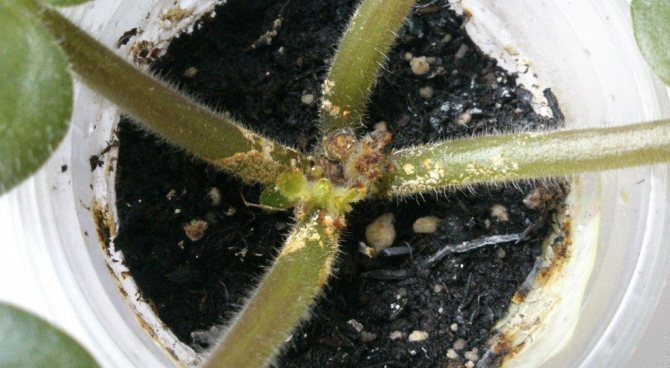

- Yellow, brown spots are formed on the foliage... This is a consequence of watering from above and falling drops on the leaves. As a result of exposure to sunlight, burns form on the foliage.
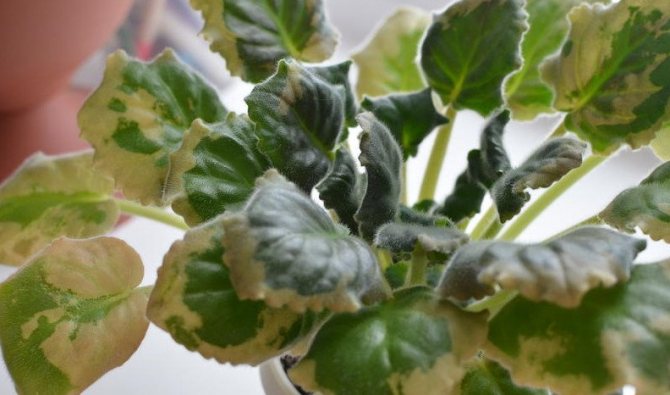

- Leaves droop and fall... This can happen both when the plant is flooded, and when there is a lack of moisture. In the first case, the leaves will become soft, in the second, they will begin to dry out.
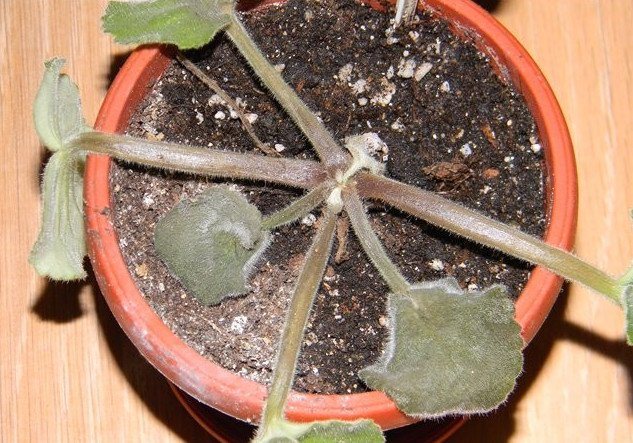

- A white-yellow crust has appeared on the soil surface... Watering with hard water is the cause of this problem.
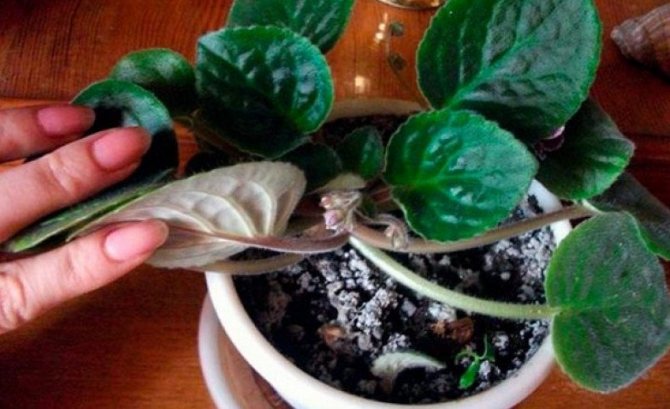

- A space has formed between the earthen lump and the wall of the pot... The frequency of moisturizing should be increased, since there is not enough moisture for the flower.
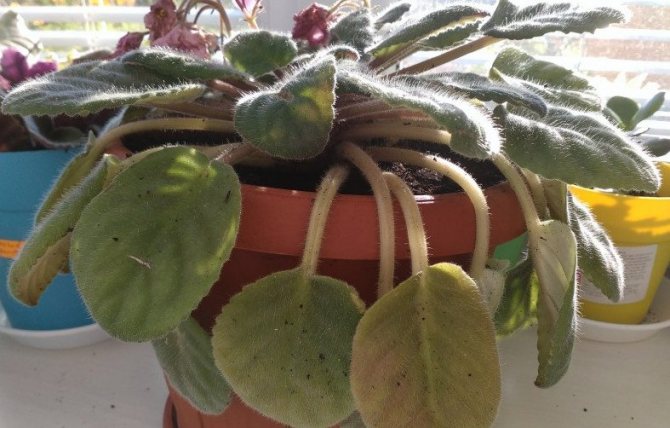

- There is a moldy smell coming from the soil... Observed with frequent bays. The plant needs an urgent transplant.
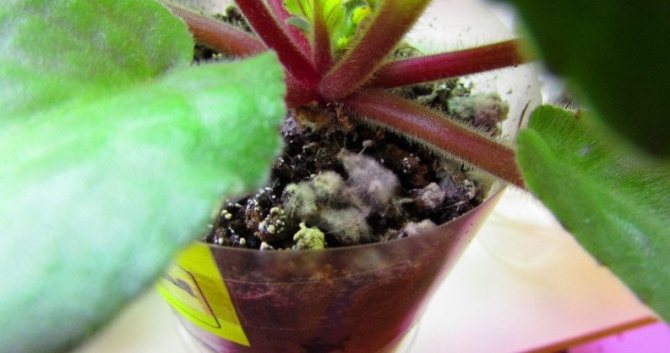

So, violets belong to capricious plants, which, even with a slight violation of the moisture regime, sharply worsen their decorative effect and die.Everyone who starts these flowers in the house should read the recommendations on the method, frequency and volume of watering and adhere to them clearly.
How to water at different stages of development, transplant, rejuvenation
Features of watering violets, at different stages of their development, are presented in the table.
| During and after the change of soil | During flowering | Rejuvenation period |
| Directly when changing land, the violet is watered abundantly 1 time. The moisture will last from 7 to 10 days. After that, the procedure is carried out no earlier than 7 days later. | When buds appear, the amount of water and the frequency of watering increase. This will ensure long lasting and abundant flowering. In order not to flood the plant, you need to focus on the color of the soil. If it is light, moisture is needed, if it is dark, it is not worth watering yet. | After removing the bad roots and changing the soil from the flower, it needs to be watered. The water is poured so that it does not fall on the leaves or in the middle of the outlet. |
Types of indoor and wild-growing violets
The following varieties are most common as indoor:
| Name | Characteristic |
| Currant sorbet | The leaves are velvety, deep green, flowers of small diameter, purple, along the edge of the petal, a dark currant shade. |
| Zemfira | The petals are arranged in a separate type, the rosette is of medium size, the leaves are light green, covered with a short downy, the color of the petals is bright purple with white blotches. |
| Magdalena | Flowers have double pink inflorescences, density of inflorescences creates a feeling of fluffy bouquet, green leaves are not glossy. |
| Queen Sabrina | The species differs in that there are fuzzy stripes on the petal, which are several shades darker than the color of the petal itself, the rosette is small, the leaves in it are dark green. |
| Winter's smile | The most beautiful view. The flowers are of an extraordinary light pink shade with a golden border, the rosettes are small, green. |
| The bride's bouquet | Large white double-type flowers are combined with rich green corrugated leaves. |
| Marshmallow | The name speaks for itself, this type has pink or white-pink shades of petals, creates a sense of splendor. |
| Pauline viardot | So named by breeders. Large burgundy wine-colored flowers, variegated, semi-oval rosette. |
The most famous wild-growing representatives:
- Marsh - a herb that came from fairy tales, has medium leaves, small flowers of muted shades of blue and purple.
- Canine - common in forests, meadows. Serves as food for butterflies.
- Vitrokka - this is the name of the garden type, better known as pansies. A hybrid form that brings together many groups.
Information! Pansies are used medicinally as a diuretic or antipyretic.
Classification
Violets are classified according to several criteria:
- leaf edge - rounded, serrated, wavy, ragged, corrugated;
- leaf form - oval, circle, semicircle, wedge, elongated;
- socket volume - micro, miniature, standard, medium-sized, large.
- coloring - one-color, two-color, poly-colored.
These are the main signs, but there are many nuances that are used to determine the species. A separate classification is considered by the type of flower, which is explained by the variety of species:
- form - classic, anyutka, star, bell, wasp;
- terry - simple, scallop, terry or semi-double;
- petals - fringed, wavy, bicolor.
The variety of plants is striking in its beauty even in photographs. It is impossible to confuse them with others if you see them at least once in a photo or video.
What to do if violets are poured
If it is noticed in time that the soil in the pot is waterlogged, and the flower has just begun to fade, it is necessary to remove the land ball and completely dry it. In the future, you need to choose a watering mode suitable for the flower.
In case of strong flooding, the plant should be transplanted.If the roots have already begun to rot, then the flower can be saved by growing its "babies" from the cuttings.
Did you know? A resident of Odessa (Ukraine) gathered in his apartment the largest collection of violets in Europe - 3.5 thousand varieties, including those grown by astronauts in orbit. To water all the specimens, the grower takes 800 liters of water per week, and on their lighting he spends 30-40$
per month.There are 2 more ways to resuscitate flooded flowers:
- Drizzle with a solution of succinic acid (0.02%);
- Drizzle with liquid vitamin B12 (1 ampoule / 1 liter of water).
Such watering will increase the immunity of the plant, normalize the soil microflora and neutralize toxins.
When growth slows down
How to water violets that do not grow? This problem usually occurs when there is a lack of nitrogen. It is easy enough to understand that the plant is starving. Young leaves are pale in color, old foliage turns yellow quickly. Fertilizers with an increased concentration of nitrogen are capable of helping the violet.
Watering indoor plants should be combined with spraying with growth stimulants. "Zircon", "Epin" - proven preparations that have a beneficial effect on young seedlings. "Zircon" will have a life-giving effect on a flower that has been watered incorrectly. Epin is used to treat diseased and damaged plants, helping them to tolerate heat more easily.
Pros and cons of each method
The positive and negative aspects of the main methods of watering violets are presented in the form of a table.
| Way | Dignity | disadvantages |
| Straight bottom | Helps to get rid of elements harmful to plants that will "leave" the pot along with water residues | There is a great risk of destroying the plant, because water can accidentally get on the leaves or the outlet |
| Pallet | Violets take this type of watering very well. | Harmful salts will rise to the roots of plants along with moisture |
| Wick | Easy to use, completely safe for flowers in the warm season. Plants themselves regulate the amount of incoming moisture | Cannot be used in winter. If you water flowers in this way, planted in pots more than 8 cm in diameter, the violets will grow large leaves and stop blooming. |
| Direct watering from above | Helps to wash out salts harmful to plants together with excess water | It is very difficult to gently water an overgrown plant with a large number of leaves so that moisture does not get on them. Trace elements useful for flowers are washed out together with water. |
| Immersion | Moisture will not get on the leaves | It is required to closely monitor the process, otherwise there is a risk of waterlogging the substrate |
The table shows that each of the methods used at home has both strengths and weaknesses. Therefore, you can choose one or another of them at will.
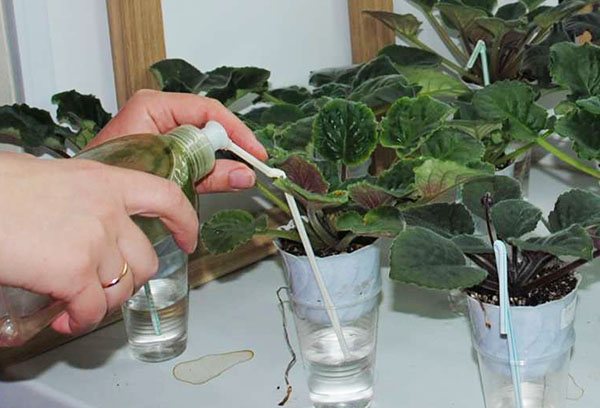

The use of potassium permanganate
A solution of potassium permanganate is a product containing manganese and potassium. These chemicals are responsible for growth and development. The solution is used during the formation of the shoot, and it is also treated with spoiled roots before transplanting.
Important! If the socket starts to rot, then this indicates an overflow.
Frequent use of potassium permanganate can adversely affect the state of Saintpaulia, the main criterion for determining the need for feeding is the appearance of the flower.
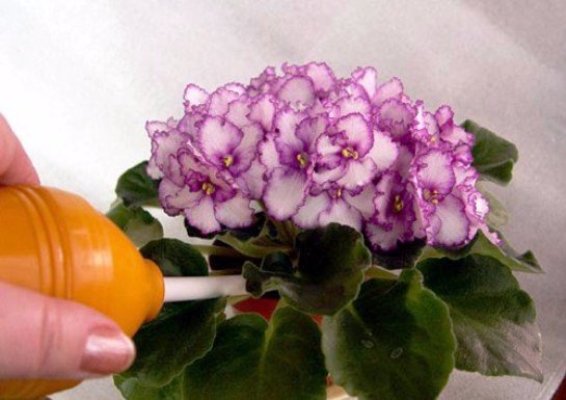

Special cases
After transplanting, the violet must also be watered correctly. Florists recommend doing this:
- prepare a pot in advance, the soil in which must be moderately moistened (it is easy to determine: the earth should not stick to your hands);
- the plant that will be transplanted in the morning is watered in advance in the evening;
- after transplanting into a new pot, the flower is not watered, you must wait 1-2 days until the soil surface dries up;
- after that, watering is carried out in the usual way.
Important!
It is impossible to transplant the plant into dry soil, there is a great risk of damaging the roots.
If the plant is accidentally flooded, it can be saved.
- You need to get the violet out of the pot, examine the roots. If they are healthy and not blackened, wrap them in a paper towel and allow them to dry.
- Next, the plant is transplanted into new soil (you can also use the old substrate, after drying it).
- Do not water the flower until the soil layer becomes lighter, that is, it dries out by 2-3 cm.
Advice
Old soil should not be used if it smells like mold.
Watering mode
Often, violets die in winter, and the reason for this is a violation of the rules of watering in cold weather, as well as hypothermia of flowers. A decrease in temperature leads to the fact that the soil does not dry out, constantly retains moisture, and the roots, in turn, rot. In this situation, you can save the plant. Noticing the first signs of wilting, you need to remove the violet from the pot and let the soil dry.
In winter, it is imperative to loosen the ground, and reduce the number of irrigations to the required level. It is best to use wick irrigation. But it is better to refuse fertilizers, or also significantly reduce.
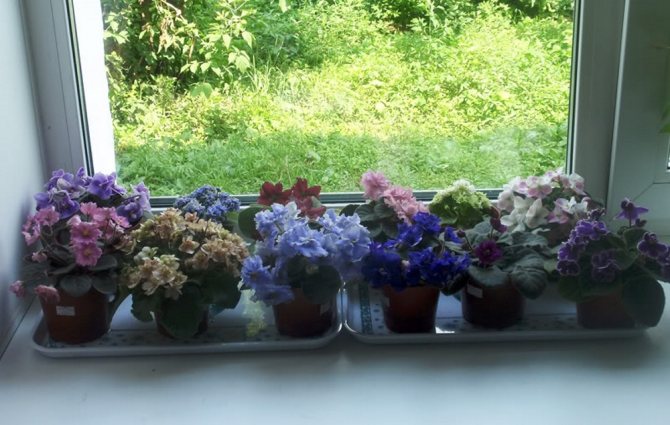

In the warm season, the violets that stand on the window are watered 2-3 times a week.
If your flowers are not on the window, then they are also susceptible to negative factors, only now it is an increased temperature and a low level of humidity, since heating devices dry out the air. In this case, you should take care of air humidification.
In summer, flowers are watered twice a week, or as the soil dries up. It all depends on the air temperature.
During the flowering period, the amount of watering increases as the plant requires moisture.
Secrets of florists
In order for plants to please the eye with rapid flowering, it is important to take into account some of the recommendations of experienced florists.
- The looser the substrate is used, the more frequent the watering should be.
- When the violets are in bloom, they need to be watered more often and more.
- Young plants actively consume moisture, so watering for them should be more intense than for old ones.
- If the room where the pots are located is dry and many appliances are turned on, you will need to water the flowers more often.
- The frequency of watering is also influenced by the material from which the pot is made. In clay "dwellings" the earth dries out faster than in plastic.
- Drainage of the pot will also help to avoid excessive watering: crushed brick, stones, expanded clay.
Watering violets correctly is quite simple, the main thing is to adhere to the recommendations and be careful not to flood the plants. The rule applies to these indoor flowers - it is better to underfill than overflow.

